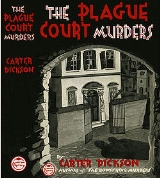
The Plague Court Murders
Encyclopedia
The Plague Court Murders is the first Sir Henry Merrivale
mystery, by the American
writer John Dickson Carr
(1906–1977), who wrote it under the name of Carter Dickson. It is a locked room mystery
of the subtype known as an "impossible crime".
, run by psychic Roger Darworth and his medium
Joseph.
However, Darworth is a fake, being monitored by the police. The night of the seance, Darworth locks himself in a small stone house, behind Plague Court, while the seance proceeds. When Masters and Blake go to get him, he has been stabbed to death, with the dagger of Louis Playge.
But all the doors and windows are bolted and locked, and thirty feet of mud surrounds the house, unbroken—and all the suspects have been holding hands in the seance.
The only one who can solve the crime is locked room expert Sir Henry Merrivale.
Chief-Inspector Masters so dominated the first 180 pages of the book, that the first US paperback edition's cover (Avon #7, 1941) said "A Chief Inspector Masters novel".
Sir Henry Merrivale
Sir Henry Merrivale is a fictional detective created by "Carter Dickson", a pen name of John Dickson Carr . Also known as "the Old Man," by his initials "H...
mystery, by the American
United States
The United States of America is a federal constitutional republic comprising fifty states and a federal district...
writer John Dickson Carr
John Dickson Carr
John Dickson Carr was an American author of detective stories, who also published under the pen names Carter Dickson, Carr Dickson and Roger Fairbairn....
(1906–1977), who wrote it under the name of Carter Dickson. It is a locked room mystery
Locked room mystery
The locked room mystery is a sub-genre of detective fiction in which a crime—almost always murder—is committed under apparently impossible circumstances. The crime in question typically involves a crime scene that no intruder could have entered or left, e.g., a locked room...
of the subtype known as an "impossible crime".
Plot summary
Ken Blake is approached by an old friend, Dean Halliday, who tells the story of his family estate, Plague Court. Halliday explains that the house is haunted by the ghost of the original owner, Louis Playge, a hangman by profession. Halliday invites Blake and Chief-Inspector Humphrey Masters to Plague Court to take part in a seanceSéance
A séance is an attempt to communicate with spirits. The word "séance" comes from the French word for "seat," "session" or "sitting," from the Old French "seoir," "to sit." In French, the word's meaning is quite general: one may, for example, speak of "une séance de cinéma"...
, run by psychic Roger Darworth and his medium
Mediumship
Mediumship is described as a form of communication with spirits. It is a practice in religious beliefs such as Spiritualism, Spiritism, Espiritismo, Candomblé, Voodoo and Umbanda.- Concept :...
Joseph.
However, Darworth is a fake, being monitored by the police. The night of the seance, Darworth locks himself in a small stone house, behind Plague Court, while the seance proceeds. When Masters and Blake go to get him, he has been stabbed to death, with the dagger of Louis Playge.
But all the doors and windows are bolted and locked, and thirty feet of mud surrounds the house, unbroken—and all the suspects have been holding hands in the seance.
The only one who can solve the crime is locked room expert Sir Henry Merrivale.
Literary significance and criticism
One of this author's celebrated locked-and-barred-room mysteries ... The telling ... is reasonably straightforward, but the plot being told is a clutter about a phony psychic investigator and his boy "medium" ... Lots of talk, some but not much detection by Sir Henry Merrivale. The great stunt at the end is unforgivably preposterous (in the literal sense).Chief-Inspector Masters so dominated the first 180 pages of the book, that the first US paperback edition's cover (Avon #7, 1941) said "A Chief Inspector Masters novel".
Publication history
- 1934, USA, William Morrow, Pub date 1934, Hardback, 312pp (first US edition)
- 1935, UK, Heinemann, Pub date 1935, Hardback, 320pp (first UK edition)
- 1941, USA, Avon 7, Pub date 1941, Paperback, (first US pb edition)
- 1951, UK, Penguin Books 820, Pub date 1951, Paperback (first UK pb edition)
- 1959, USA, Berkley G267 ISBN 1-55882-062-0, Pub date 1959, Paperback
- 1990, USA, International Polygonic ISBN 1-55882-062-0, Pub date July 1990, Paperback, 312pp (Library of Crime Classics, introduction by Douglas G. Greene)

